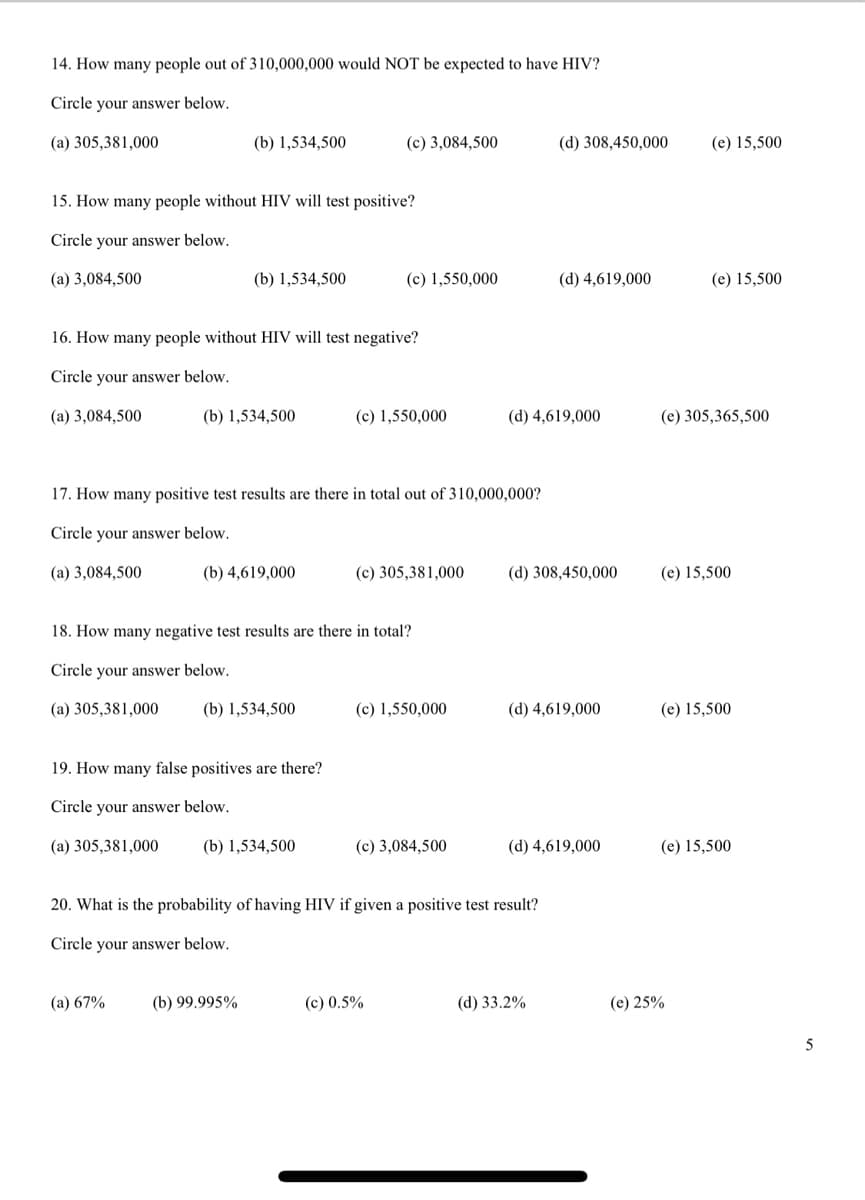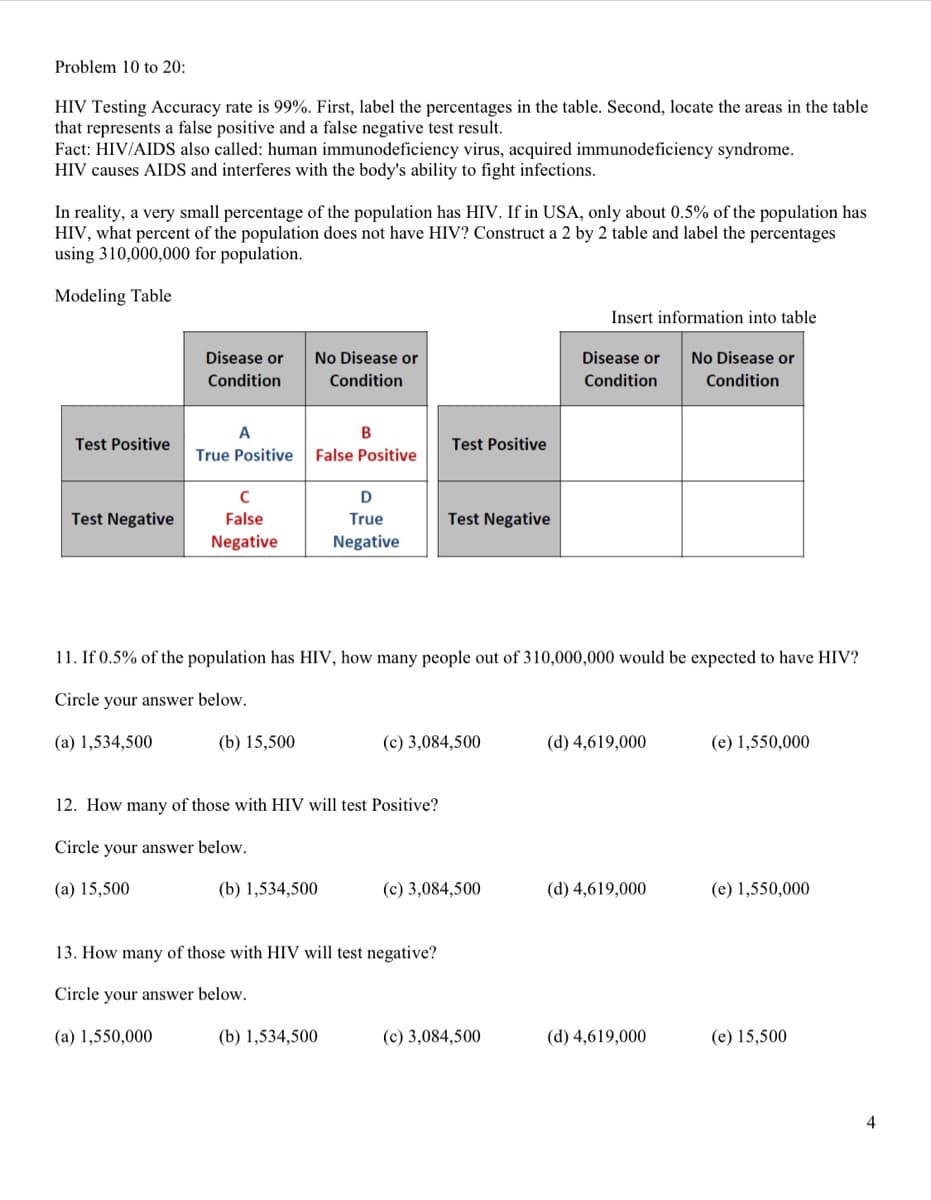11. If 0.5% of the population has HIV, how many people out of 310,000,000 would be expected to have HIV? Circle your answer below. (a) 1,534,500 (b) 15,500 (c) 3,084,500 (d) 4,619,000 (e) 1,550,000
11. If 0.5% of the population has HIV, how many people out of 310,000,000 would be expected to have HIV? Circle your answer below. (a) 1,534,500 (b) 15,500 (c) 3,084,500 (d) 4,619,000 (e) 1,550,000
MATLAB: An Introduction with Applications
6th Edition
ISBN:9781119256830
Author:Amos Gilat
Publisher:Amos Gilat
Chapter1: Starting With Matlab
Section: Chapter Questions
Problem 1P
Related questions
Question

Transcribed Image Text:14. How many people out of 310,000,000 would NOT be expected to have HIV?
Circle your answer below.
(a) 305,381,000
(b) 1,534,500
(c) 3,084,500
(d) 308,450,000
(e) 15,500
15. How many people without HIV will test positive?
Circle your answer below.
(a) 3,084,500
(b) 1,534,500
(c) 1,550,000
(d) 4,619,000
(e) 15,500
16. How many people without HIV will test negative?
Circle your answer below.
(a) 3,084,500
(b) 1,534,500
(c) 1,550,000
(d) 4,619,000
(e) 305,365,500
17. How many positive test results are there in total out of 310,000,000?
Circle your answer below.
(a) 3,084,500
(b) 4,619,000
(c) 305,381,000
(d) 308,450,000
(e) 15,500
18. How many negative test results are there in total?
Circle your answer below.
(a) 305,381,000
(b) 1,534,500
(c) 1,550,000
(d) 4,619,000
(e) 15,500
19. How many false positives are there?
Circle your answer below.
(a) 305,381,000
(b) 1,534,500
(c) 3,084,500
(d) 4,619,000
(e) 15,500
20. What is the probability of having HIV if given a positive test result?
Circle your answer below.
(a) 67%
(b) 99.995%
(c) 0.5%
(d) 33.2%
(e) 25%
5

Transcribed Image Text:Problem 10 to 20:
HIV Testing Accuracy rate is 99%. First, label the percentages in the table. Second, locate the areas in the table
that represents a false positive and a false negative test result.
Fact: HIV/AIDS also called: human immunodeficiency virus, acquired immunodeficiency syndrome.
HIV causes AIDS and interferes with the body's ability to fight infections.
In reality, a very small percentage of the population has HIV. If in USA, only about 0.5% of the population has
HIV, what percent of the population does not have HIV? Construct a 2 by 2 table and label the percentages
using 310,000,000 for population.
Modeling Table
Insert information into table
Disease or
No Disease or
Disease or
No Disease or
Condition
Condition
Condition
Condition
A
Test Positive
Test Positive
True Positive
False Positive
D
Test Negative
False
True
Test Negative
Negative
Negative
11. If 0.5% of the population has HIV, how many people out of 310,000,000 would be expected to have HIV?
Circle your answer below.
(a) 1,534,500
(b) 15,500
(c) 3,084,500
(d) 4,619,000
(e) 1,550,000
12. How many of those with HIV will test Positive?
Circle your answer below.
(a) 15,500
(b) 1,534,500
(c) 3,084,500
(d) 4,619,000
(e) 1,550,000
13. How many of those with HIV will test negative?
Circle your answer below.
(a) 1,550,000
(b) 1,534,500
(c) 3,084,500
(d) 4,619,000
(e) 15,500
4
Expert Solution
This question has been solved!
Explore an expertly crafted, step-by-step solution for a thorough understanding of key concepts.
This is a popular solution!
Trending now
This is a popular solution!
Step by step
Solved in 2 steps with 1 images

Knowledge Booster
Learn more about
Need a deep-dive on the concept behind this application? Look no further. Learn more about this topic, statistics and related others by exploring similar questions and additional content below.Recommended textbooks for you

MATLAB: An Introduction with Applications
Statistics
ISBN:
9781119256830
Author:
Amos Gilat
Publisher:
John Wiley & Sons Inc

Probability and Statistics for Engineering and th…
Statistics
ISBN:
9781305251809
Author:
Jay L. Devore
Publisher:
Cengage Learning

Statistics for The Behavioral Sciences (MindTap C…
Statistics
ISBN:
9781305504912
Author:
Frederick J Gravetter, Larry B. Wallnau
Publisher:
Cengage Learning

MATLAB: An Introduction with Applications
Statistics
ISBN:
9781119256830
Author:
Amos Gilat
Publisher:
John Wiley & Sons Inc

Probability and Statistics for Engineering and th…
Statistics
ISBN:
9781305251809
Author:
Jay L. Devore
Publisher:
Cengage Learning

Statistics for The Behavioral Sciences (MindTap C…
Statistics
ISBN:
9781305504912
Author:
Frederick J Gravetter, Larry B. Wallnau
Publisher:
Cengage Learning

Elementary Statistics: Picturing the World (7th E…
Statistics
ISBN:
9780134683416
Author:
Ron Larson, Betsy Farber
Publisher:
PEARSON

The Basic Practice of Statistics
Statistics
ISBN:
9781319042578
Author:
David S. Moore, William I. Notz, Michael A. Fligner
Publisher:
W. H. Freeman

Introduction to the Practice of Statistics
Statistics
ISBN:
9781319013387
Author:
David S. Moore, George P. McCabe, Bruce A. Craig
Publisher:
W. H. Freeman